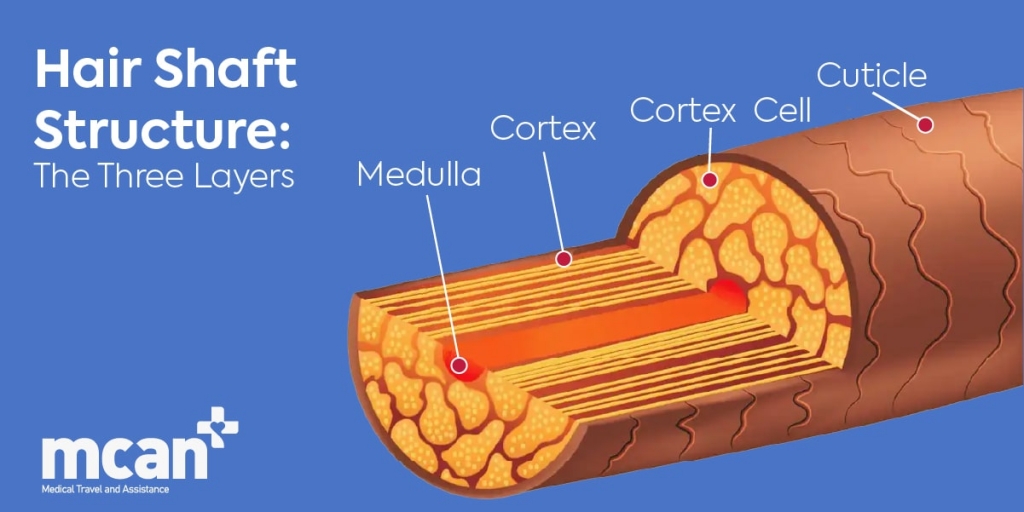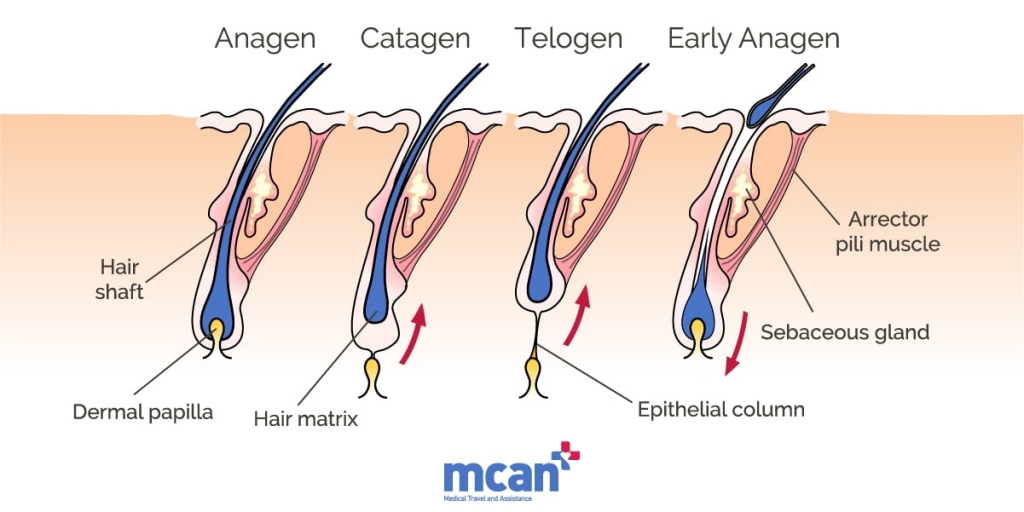
Most people think of hair as the visible strands on the surface (the part we wash), style, and notice thinning in. But the real story of hair begins beneath the scalp, in a complex system of layers, follicles, and growth cycles that work together to produce every single strand. Understanding this structure is not only fascinating; it’s essential for understanding why hair grows, why it breaks, and why certain types of hair loss occur.
Whether you’re dealing with changes in thickness, experiencing increased shedding, or simply curious about how hair grows, knowing what the hair structure diagram shows can make things much clearer. Each part of the strand and follicle plays a specific role, and when one part is damaged or disrupted, the effects become visible over time.
In this article, we’ll break down the hair structure diagram step by step. You’ll learn how the layers of the hair shaft protect it, how the follicle functions like a tiny biological factory, and how the hair growth cycle determines shedding and regrowth. We’ll also explain how this structure relates to different types of hair loss and why understanding it helps guide effective treatment — whether cosmetic, medical, or surgical.
Overview of Hair Anatomy
Hair may look simple from the outside, but it is built from several coordinated structures. These structures fall into two main parts: the hair shaft, which is the visible strand above the skin, and the hair follicle, which sits beneath the scalp and produces the hair. The shaft shows the results of daily wear, styling, and environmental exposure, while the follicle is responsible for growth, strength, and long-term hair health.
Healthy hair depends far more on what happens below the surface than on what we see. The follicle, with its supporting cells, glands, and growth signals, determines how thick, strong, or resilient each strand becomes. Understanding these components helps explain why some hair concerns are cosmetic, while others indicate deeper structural or growth-related issues.

Hair Shaft Structure: The Three Layers
The hair shaft is the part of the hair that sits above the scalp and is visible to the eye. Although it looks like a single strand, it is built from three distinct layers. Each layer plays a different role in how the hair behaves, how it reacts to styling, and how it shows signs of damage.

Cuticle
The cuticle is the outermost layer made of flat, overlapping cells. It protects the inner structure of the hair, controls shine, and helps the strand resist external damage. When the cuticle is smooth, hair appears glossy and feels soft. When it is lifted or worn down by heat, chemicals, or friction, hair becomes dull, rough, and prone to breakage.
Cortex
The cortex is the thickest layer and gives hair most of its strength and elasticity. It contains long keratin fibers and natural pigments that determine hair color. This is also where chemical treatments such as coloring or perming take effect. Damage to the cortex leads to weakness, loss of elasticity, and easier breakage.
Medulla
The medulla is the central, soft core of the strand. It is present mainly in thicker or coarser hair types and may be absent in very fine hair. Although it does not play a major role in everyday hair health, it is part of the strand’s structural makeup.
Hair Follicle Structure: What You Do Not See
The hair follicle sits beneath the scalp and is responsible for producing every strand of hair. It contains several structures that work together to support growth, strength, and long-term hair health.
- Hair bulb: The rounded base of the follicle where active cell division creates the hair shaft.
- Dermal papilla: The nutrient and signal center that supplies oxygen, minerals, and growth instructions to the bulb.
- Sebaceous gland: Produces sebum that coats the hair and scalp to maintain moisture and protect the cuticle.
- Arrector pili muscle: A small muscle that causes goosebumps and helps move sebum upward along the hair.
- Inner and outer root sheath: Protective layers that support the growing hair and guide it toward the skin surface.
Hair Growth Cycle Explained
Every strand of hair moves through a repeating cycle that controls how long it grows, when it rests, and when it sheds. This cycle explains why daily shedding is normal and why certain types of hair loss appear suddenly.
| Phase | Duration | What Happens |
|---|---|---|
| Anagen (Growth) | 2 to 7 years | Hair actively grows; most hairs are in this phase. |
| Catagen (Transition) | 2 to 3 weeks | Growth slows and the follicle begins to detach from its blood supply. |
| Telogen (Resting) | 2 to 4 months | The hair stops growing but remains anchored in the follicle. |
| Exogen (Shedding) | Varies | The old hair releases and falls out naturally; 50 to 100 hairs per day is normal. |
Disruptions to this cycle can cause many hairs to enter the resting and shedding phases at the same time. This is common in telogen effluvium, where shedding increases rapidly despite the follicles remaining healthy.
How Hair Actually Grows

Hair growth is a continuous biological process that happens deep within the follicle. Although the visible strand looks simple, it takes several coordinated steps for each hair to form, strengthen, and move toward the surface of the scalp.
Hair growth begins in the bulb, where specialized matrix cells divide rapidly. These new cells push older ones upward while filling with keratin, the protein that gives hair its structure. As the cells move higher through the follicle, they harden and form the hair shaft. The root sheaths protect and guide the strand during this journey, while the sebaceous gland coats it with natural oils to keep the cuticle smooth. Eventually, the hair emerges from the scalp as a fully formed strand.
The process repeats continuously during the anagen phase, and healthy follicles maintain this steady rhythm for years. When the follicle enters its resting phases, growth slows and eventually pauses until the next cycle begins.
Factors That Affect Hair Structure and Growth
Hair structure is influenced by both internal and external factors. Some determine how hair naturally grows, while others affect its strength, texture, and long-term health.
Internal factors that influence hair growth:
- Genetics that shape hair thickness, curl pattern, and growth rate
- Hormonal changes that can alter density or trigger shedding
- Nutrient levels such as iron, zinc, vitamin D, and protein
- Age, which gradually reduces growth speed and strand diameter
External factors that can affect hair quality:
- Heat styling and chemical treatments that weaken the cuticle and cortex
- Sun exposure that dries the hair and fades natural pigment
- Tight hairstyles that create tension and traction on follicles
- Scalp inflammation or buildup that interferes with healthy growth
Damage to the cuticle or cortex changes how the hair looks and feels, while damage at the follicle level affects long-term density and overall growth.
Hair Structure and Hair Loss
Different types of hair loss make much more sense once you understand how the hair shaft and follicle function. Most problems begin below the scalp, where growth signals, nutrition, and structural support take place.

Miniaturization in the Follicle
Miniaturization is a gradual weakening of the follicle that affects how thick and strong each new strand becomes.
- The dermal papilla becomes smaller and sends fewer growth signals.
- New hairs grow thinner, shorter, and softer.
- Coverage decreases even when follicles are still present.
- This is the core process behind androgenetic alopecia.
Cycle Disruptions and Sudden Shedding
Some conditions interrupt the normal growth cycle, causing large numbers of hairs to enter rest and shed at the same time.
- Telogen effluvium is the most common example.
- Follicles remain healthy but shift into resting phases too early.
- Shedding increases quickly, often within weeks.
- Hair usually regrows once the trigger is resolved.
Inflammation or Scarring
Certain conditions damage the follicle itself, which can lead to permanent loss if untreated.
- Chronic inflammation can weaken the follicle over time.
- Scarring alopecias destroy the follicle and stop new growth.
- Early evaluation is essential to prevent long-term damage.
Hair Shaft Breakage
Not all thinning starts at the follicle; some concerns are caused by damage to the visible hair strand.
- Heat styling and chemicals weaken the cortex.
- A rough cuticle makes hair dull, frizzy, and prone to snapping.
- Breakage reduces length and fullness but not follicle count.
- This leads to cosmetic thinning rather than true medical thinning.
Why Understanding Hair Structure Helps With Hair Transplant Planning?

Knowing how the hair shaft and follicle are built is essential for predicting hair transplant outcomes. A transplant does not simply move visible strands. It moves entire follicular units, and the health of each structural component determines how well grafts survive and how natural the final result looks.
Follicle Health Determines Graft Survival
A successful transplant depends on strong, healthy follicles that can survive extraction and regrow in a new location.
- A robust dermal papilla produces thicker, stronger hairs after transplantation.
- Miniaturized follicles may survive the procedure but produce weak, thin strands.
- Assessing follicle size and root sheath integrity helps identify the strongest grafts.
Hair Shaft Structure Affects Density and Coverage
The visible appearance of fullness depends on shaft diameter and strength.
- Thicker cortices create better coverage after transplantation.
- Fine hair provides softer, less dense results even with high graft counts.
- Understanding shaft thickness helps set realistic expectations.
Growth Cycle Awareness Improves Timing
The transplant must be performed when the hair growth cycle is stable.
- Excessive telogen phase activity can cause temporary shock loss.
- Normal anagen distribution ensures stronger immediate growth after surgery.
- Cycle evaluation helps avoid operating during active shedding.
Scalp and Root Sheath Condition Guides Technique Choice
Certain structural conditions make some techniques more suitable than others.
- Fragile root sheaths benefit from DHI due to reduced handling.
- Strong, stable follicles tolerate FUE or Sapphire FUE extraction well.
- Technique choice protects the follicle throughout the procedure.
Donor Area Structure Predicts Long-Term Success
A transplant is only as strong as the donor region it relies on.
- Uniform follicle structure ensures consistent graft quality.
- Miniaturization in the donor area is a warning sign of future thinning.
- Detailed structural analysis prevents visible overharvesting.
Hair Transplant Perspective: How Follicle Structure Influences Success
A successful hair transplant depends on more than graft numbers or technique. It relies on the structural quality of each follicle being moved. Every follicular unit contains its own growth center, protective layers, and individual hairs, and the condition of these components determines how well the graft will survive, grow, and maintain density after transplantation.
Even when two follicles look similar on the surface, their internal structure may be completely different. A strong dermal papilla can produce a thick, healthy strand for many years, while a weakened papilla leads to fine, fragile hairs. The integrity of the root sheath affects whether the graft survives the extraction process. The stability of the donor area predicts whether transplanted hair will continue to grow naturally over time.
How Follicle Structure Affects Hair Transplant Success
| Aspect of Follicle Structure | Why It Matters for Transplant Success |
|---|---|
| Follicular Units | Natural groupings of 1–4 hairs determine how full and natural the transplanted area will look. Strong units create better density, while miniaturized ones provide weaker coverage. |
| Dermal Papilla Health | The growth center of the follicle. A healthy papilla supports thick, durable regrowth; a shrinking papilla leads to thin, soft strands even if the graft survives. |
| Root Sheath Integrity | The sheath protects the follicle during extraction and implantation. Damage lowers graft survival and slows early growth. Clean removal produces better outcomes. |
| Follicle Thickness and Strength | Thick follicles deliver more coverage after transplantation. Fine or fragile follicles may survive surgery but create less visible density. |
| Technique Compatibility | FUE suits strong follicles, Sapphire FUE allows dense packing with fine incisions, and DHI protects delicate grafts with minimal handling. Matching technique to follicle structure boosts success. |
| Donor Area Stability | Only genetically stable follicles continue to grow reliably after relocation. Donor miniaturization increases the risk of long-term thinning in the transplanted area. |
Hair Transplant in Turkey and the Importance of Hair Structure Knowledge with MCAN Health
Understanding how the hair shaft and follicle work is more than scientific curiosity. It is one of the most important foundations for safe and successful hair restoration. Every graft extracted during a hair transplant carries its own growth center, protective layers, and structural characteristics, which is why a detailed understanding of hair anatomy helps ensure strong, natural, and long-lasting results.

At MCAN Health, this anatomical knowledge is part of every step of the patient journey. Before any procedure begins, our specialists examine the condition of your follicles, evaluate the strength of the donor area, and determine how each follicular unit will behave after transplantation. This allows us to choose the most suitable technique and the healthiest grafts for each patient.
When you choose MCAN Health for your hair transplant in Turkey, you benefit from:
- Precise follicle assessment: We evaluate follicle structure, dermal papilla health, and donor stability to confirm whether grafts are strong enough to produce lasting growth.
- Advanced surgical techniques: FUE, Sapphire FUE, and DHI are selected strategically to protect follicle integrity and achieve high-density, natural-looking results.
- Comprehensive patient support: From airport transfers and accommodation to detailed aftercare, every part of the process is managed with comfort and clarity.
- Ethical, long-term planning: We preserve donor areas, set realistic expectations, and focus on sustainable results based on your unique hair structure and growth patterns.
At MCAN Health, we combine scientific understanding of hair anatomy with leading surgical expertise to deliver results that look natural and stand the test of time. Whether you are considering a hair transplant for the first time or seeking professional guidance, our team is committed to helping you achieve stronger, healthier, and more confident hair growth.
 How to Choose the Best Hair Loss Clinic? – A Must-Have Checklist!
How to Choose the Best Hair Loss Clinic? – A Must-Have Checklist!  How Much Hair is Normal to Lose in the Shower?
How Much Hair is Normal to Lose in the Shower?  Do I Need a Breast Implants Replacement? How Often?
Do I Need a Breast Implants Replacement? How Often?